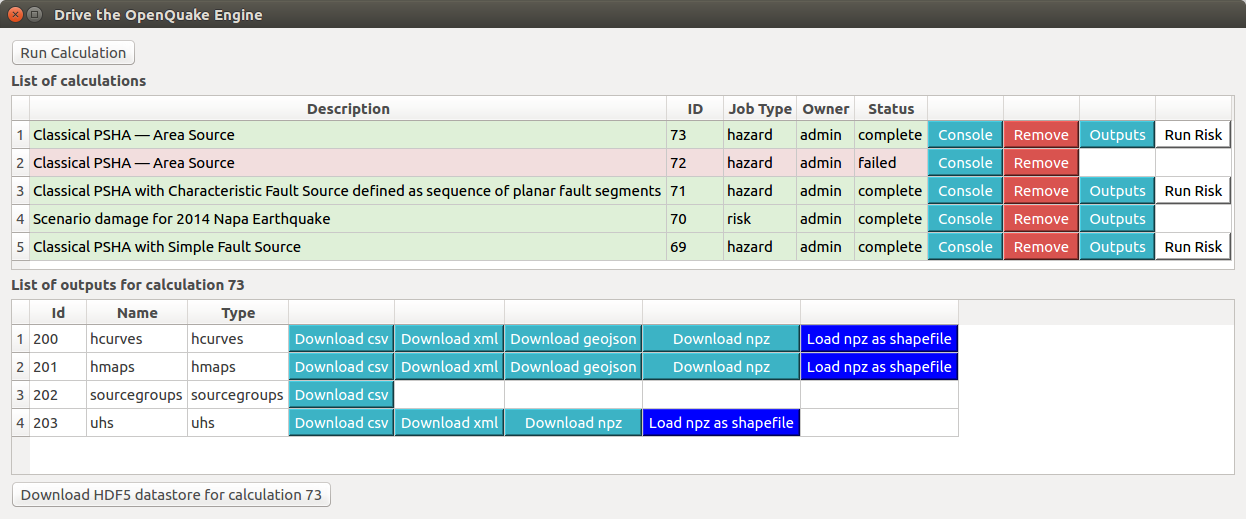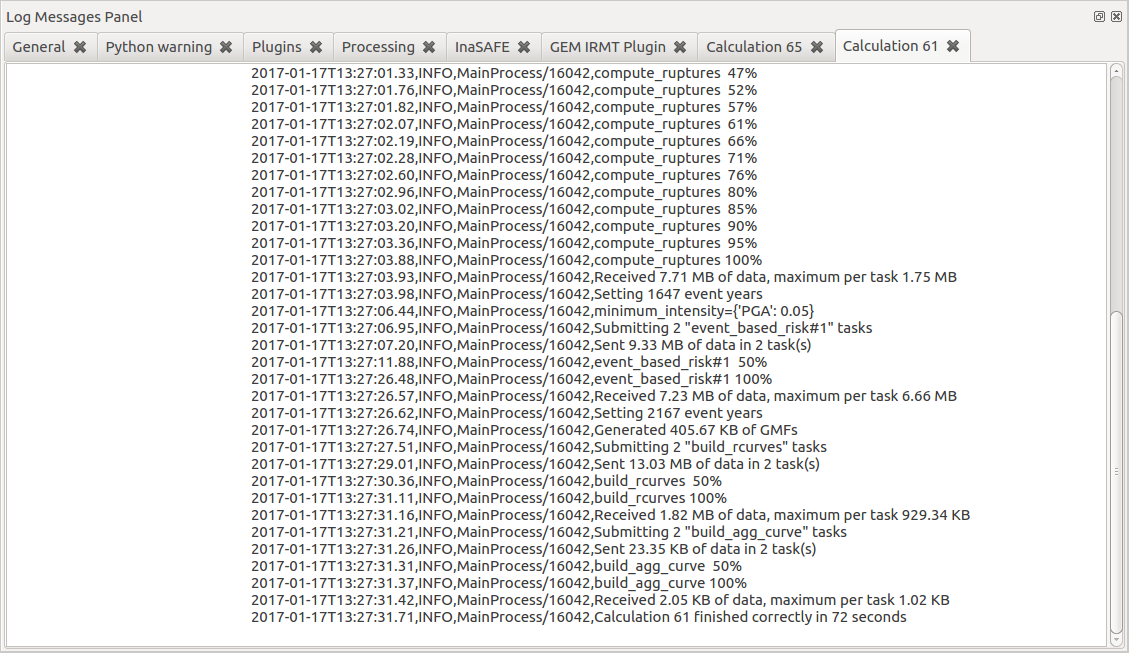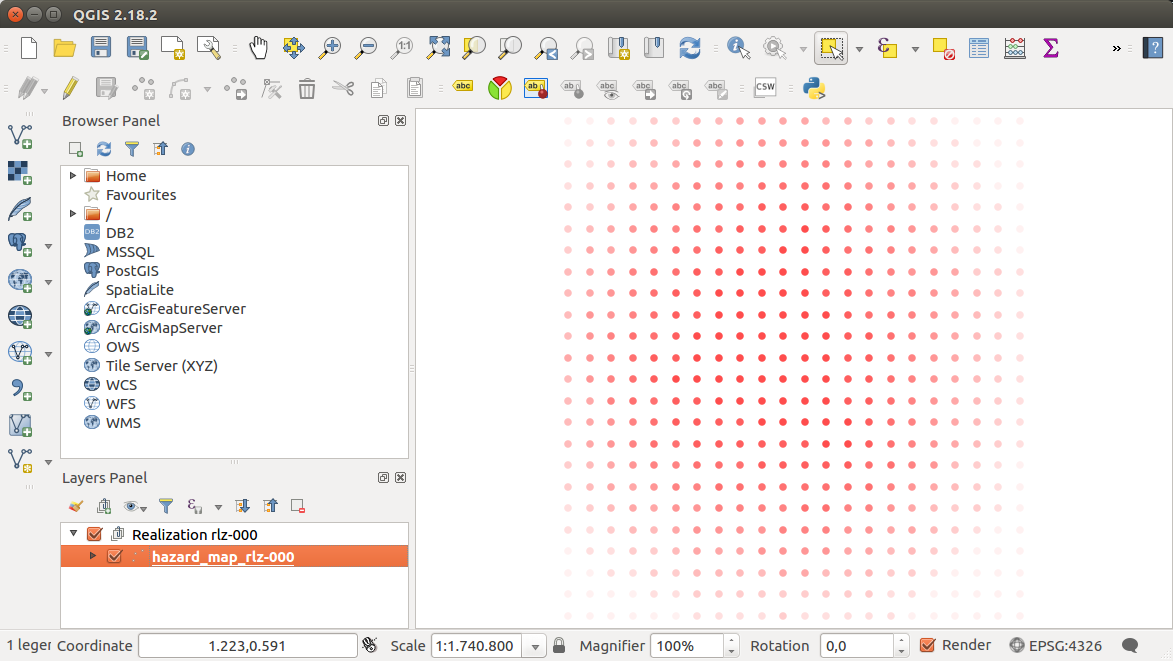15. Driving the OpenQuake Engine¶
The plugin enables to drive the OpenQuake Engine, submitting new jobs, watching calculation progress, retrieving and visualizing results, seamlessly within the QGIS interface. This is made possible by leveraging the OpenQuake Engine Server’s HTTP RESTful API. The connection with a running OQ-Engine Server has to be properly set up as described in IRMT settings. The server can run locally in the same computer where QGIS is running, or remotely. For instance, it is possible to connect to a remote cluster, to perform jobs that are highly demanding in terms of computational resources.
15.1. Run a calculation¶
When the Run Calculation button is pressed, a file explorer is opened, enabling to select the input files needed to run the job (or a zip archive containing them), including the job.ini file. By pressing Open to confirm, the job is submitted. The interface keeps querying the server asynchronously, and displaying the status of the calculation.
15.2. Watch the console log¶
It is possible to watch the log of a calculation, by pressing the Console button in the corresponding row. The log will be displayed in a tab of the QGIS Log Message Panel, as shown in Example of console output for a OQ-Engine calculation.
15.3. Download outputs¶
If a calculation was completed successfully, an Outputs button is provided. When it is clicked, the list of available outputs is shown, which depends on the type of artifacts generated by the calculation. Outputs can be downloaded in one of the available formats, by clicking the corresponding button. In some cases, they can also be loaded as QGIS layers (whenever a corresponding Load as layer button is available), and a default styling is applied, based on parameters chosen by the user.
Warning
The layers that are automatically imported from OQ-Engine outputs are stored in memory, unless they are explicitly saved by the user into a persistent format, such as a shapefile. Please be aware that the contents of in memory layers will not be saved when the QGIS project that contains them is saved. Furthermore, saving an in memory layer into a persistent file, only the contents of the layer will be saved, and not its style. If you want to save also the style, you have to right-click on the original layer and select Styles -> Copy Style, and then do the same on the target persistent layer and select Styles -> Paste Style.
It is also possible to download the HDF5 datastore corresponding to a chosen calculation. When the Outputs button is pressed, the Download HDF5 datastore for calculation N button is enabled (where N is the calculation ID). By pressing it and selecting a destination folder, the file is downloaded and its full path is displayed both in the QGIS message bar and in the Log Messages Panel.
A hazard map defines the geographic distribution of the values of a scalar IMT (see also Definitions and acronyms) characterized by a fixed probability of being exceeded at least once in a time span T. For computing a hazard map with the OpenQuake-engine the user defines an IMT, a region over which the map will be computed and, the corresponding probability of exceedance. An alternative representation of a hazard map fixes the value of IMT and computes over an area the corresponding probability of at least on exceedance in T; this typology of result is currently not supported by the OpenQuake-engine.
Other kinds of outputs (e.g. hazard curves and uniform hazard spectra) can be visualized in the IRMT Data Viewer (see The IRMT Data Viewer).
15.4. Run a postprocessing (or risk) calculation on top of a previously computed hazard¶
To run a postprocessing or risk calculation on top of a previous hazard one you have to click the Continue button on the corresponding hazard calculation and select the files including the postprocessing or risk job.ini and the related inputs (or a zip archive containing them).
15.5. Remove a calculation¶
To remove a calculation, press the Remove button. It will remove the calculation from the list, from the database and from the datastore.
15.6. Calculation status¶
The Status column of the List of calculations indicates the current status of a calculation, which can be one of the following: created, executing, complete, failed.
The reason behind a failed calculation can be inspected by watching the console log, by means of the Console button.


